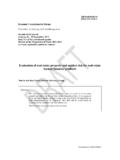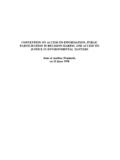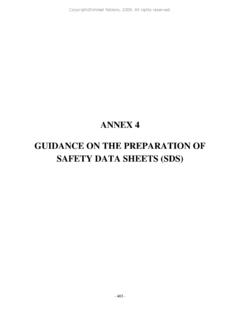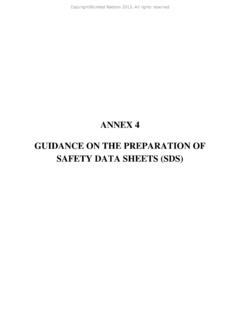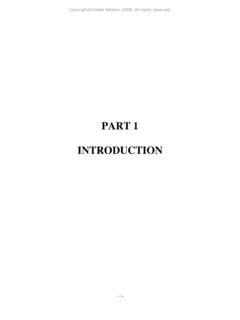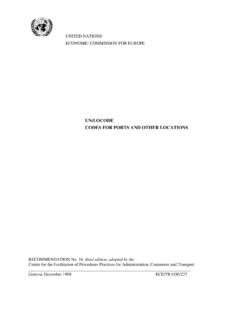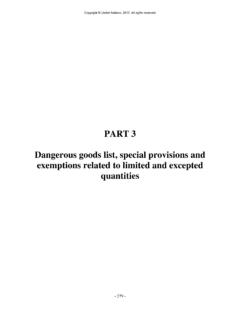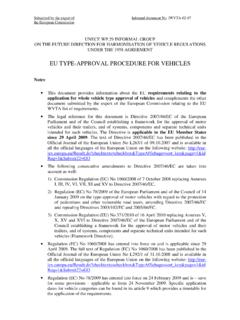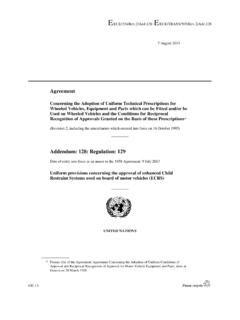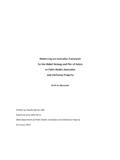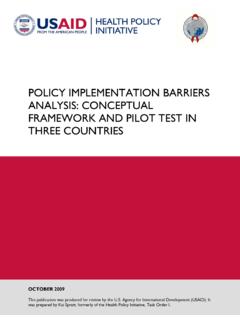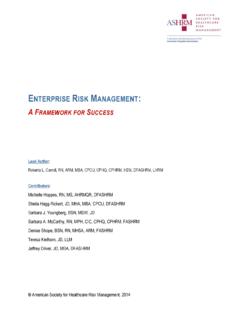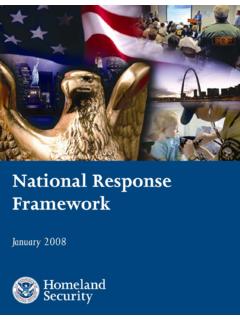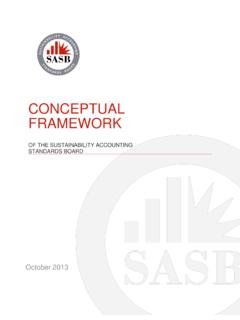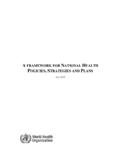Transcription of Single Window Implementation Framework final August2011
1 Page 1 of 77 UNITED NATIONS ECONOMIC COMMISSION FOR EUROPE Single Window Implementation Framework This document was developed under the Information Technology for Adoption and Intelligent Design for e-Government (ITAIDE) project funded under the EU Sixth Framework Programme. UNITED NATIONS Geneva and New York, 2011 Page 2 of 78 Page 3 of 78 Single Window Implementation Framework Authors: Name: Organisation: Eveline van Stijn* Free University Amsterdam Thayanan Phuaphanthong Kasetsart University Somnuk Kerotho Kasetsart University Markus Pikart United Nations Economic Commission for Europe Wout Hofman TNO Yao-Hua Tan Free University Amsterdam/ TU Delft Page 4 of 78 Preface of the UNECE Secretariat A Single Window is a one-stop to exchange information between traders and government agencies.
2 It greatly reduces the complexity, time and costs involved in international trade. Many countries, including developing countries and transition economies, regard Single Window as an important instrument to increase the competitiveness of their national economy. The United Nations Economic Commission for Europe (UNECE) through its specialized working party the Centre for Trade Facilitation and Electronic Business (UN/CEFACT) is developing standards for Single Window . Through the United Nations Network of Experts for paperless Trade (UNNExT) UNECE and UNESCAP offer high-level advisory services and capacity-building to support their members in implementing Single windows . When implementing a Single Window , Government officials need to manage many interlinked issues coming from very different disciplines such as trade policy, trade procedures, change management, laws and regulations, standards and technology.
3 The success of Single Window projects depends on the ability of the policy and project managers to address and resolve these issues efficiently in a manner that is supported by all stakeholders. To support managers, UNECE developed the Single Window Implementation Framework (SWIF), a managerial tool to plan and implement Single Window projects. SWIF combines the latest standards and best practice for designing efficient enterprise architectures for large-scale, collaborative interagency information systems with the knowledge of and lessons learned by experienced implementers. The development of SWIF was only possible through the collaboration between academia and practitioners. SWIF was developed under the European Union (EU) research project ITAIDE, which has provided a valuable research and living lab experience for developing e-Government in the EU.
4 UNECE would like to express their specific gratitude to the European Commission and the following Universities and institutions for the development of SWIF: Free University of Amsterdam, Delft University of Technology, Inova Institute of Kasetsart University Bangkok and TNO. UNECE is confident that their research and experience will be of immense value to member countries. Page 5 of 78 SUMMARY Many governments worldwide have adopted the Single Window initiative as a national Programme of work since they recognize that Single Window is a crucial instrument that can be used to eliminate inefficiency and ineffectiveness in business and government procedures and document requirements along the international supply chain, reduce trade transaction costs, as well as improve border control, compliance, and security.
5 Single Window systems are considered to be a means to establish improved information sharing between government agencies and businesses involved in cross-border trade. A Single Window can be used as a one-stop shop for traders and other commercial organizations to exchange information with the government agencies that, based on regulation and control procedures, require data on a variety of aspects of the trade transactions and the flow of goods through the international supply chain. The Implementation of a SW faces complicated challenges that relate not only to the technical aspects of SW systems, but also to the organizational and inter-organizational, managerial, financial, political, legal, and national and international settings. As policy managers who are involved in initiating and overseeing the management of SW implementations, need to develop a strategy transforming their vision into Implementation , a strategic and holistic Framework that informs how the Implementation challenges can be systematically addressed is much needed.
6 For this purpose, we introduce the Single Window Implementation Framework (SWIF). It builds upon the use of enterprise architecture to decompose and structure the challenges that accompany a Single Window Implementation . The SWIF is an adaptation of the TOGAF Architecture Development Method to the specific requirements and features of Single Window projects. Part I of the SWIF provides the conceptualization of the Framework . The guiding principles underpinning the SWIF are phasing and alignment. SW implementations need to align Information Systems (IS) and business strategies within the national but also international setting and developments for the long-run success. SW implementations typically follow a step-wise, phased approach and the SWIF provides a coordination mechanism between the overall SW Programme and sub-projects.
7 Sub-projects involve a smaller set of stakeholders, based on prioritization and impact, and may focus on a sub-set of activities of the SWIF method. Through cycling and iterations, as well as the (re-) use of artifacts related to the SW architecture, these sub-projects are coordinated with the overall SW Implementation . Part II of the SWIF presents a set of guidelines and techniques related to five areas that are essential for SW Implementation , and that differ substantially from other information system Implementation , thus requiring further adaptation of the TOGAF work. These areas are stakeholder management and interagency collaboration, business process analysis and simplification, data harmonization, interoperability, and the realization of the legal Framework .
8 The SWIF can also be seen as a useful structure for case comparison, as we have found for the SW Implementation cases of Thailand and The Netherlands, which helps to synthesize lessons learned from prior and on-going SW implementations. For the future, this also facilitates the SWIF to the contexts of Single Window implementations in specific countries. Additional work on the SWIF can be used to further evaluate, adapt and tailor the SWIF. For example, we have already started to relate the SWIF to other results of the ITAIDE research, and to tailor the discussion further to the European context1. Moreover, the UN is also preparing A Manager s Guide to Single Window Implementation based on the ideas presented in this deliverable. Future work on the SWIF could also focus on the development of a series of blueprints to prepare the National Master Plans, which we see as Part III of the SWIF, in order to facilitate the application of the SWIF during SW implementations.
9 1 Van Stijn, E., Phuaphanthong, T., Kerotho, S., Pikart, M., Hofman, W., and Tan, Y. (2010). Implementation Framework for e-Solutions for Trade Facilitation. In: Tan, Y., Bj rn-Andersen, N., Klein, S. and Rukanova, B. (Eds.) (2010). Accelerating Global Supply Chains with IT-innovation: ITAIDE tools and methods. 1st edition. Springer, 285-317. Page 6 of 78 PREFACE Part of the research efforts in the ITAIDE project have focused on the topic of Single Window (SW). ITAIDE Deliverable :4 State of Art has presented five case studies of Single Window systems implemented by the public authorities, in particular, the Customs of Australia, Denmark, Hong-Kong, Japan and Singapore. Those countries are considered to be among the most technologically advanced adopters of e-Government solutions.
10 The SW systems presentation and the analysis both in terms of technical and organizational Implementation offer useful insights by highlighting the technical and organizational challenges faced by Customs in each case while discussing the solutions provided as well as the main benefits for the stakeholders involved. This document essentially has provided a state of art review of existing Single Window systems, a comparison between the different systems and the solutions provided, and recommendations for the technical and the organizational Implementation of Single Window . This ITAIDE Deliverable :4b Single Window Implementation Framework is a continuation of the SW research, and presents the Single Window Implementation Framework (SWIF). The SWIF presents a systematic, aligned and phased, way of dealing with Single Window Implementation challenges.
